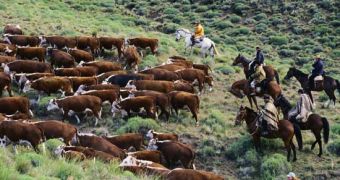They are part of the history and legend of the austral planes even from the colonial times. These tough and hard men enjoy the vast spaces, grazing the cattle, in a life half spent riding a horse.
It all started in the 17th and 18th centuries, when the Spanish started colonizing the Argentinian lands south of Rio de la Plata. In the inhospitable plains, where the only tree you can find is the poisonous ombu, life was constantly menaced, that's why the character of the gaucho was modeled to be strong, haughty, energetic, always displaying bravery, skill, some violence, enormous longing for freedom and a rejection of justice made by a central power, whose victim he has often been.
The great abundance of pastures turned cattle raising into the main activity of the campo's inhabitants (including Natives and some Blacks) and also a way to survive. Having a horse was a must.
Gaucho's clothing is made of shirt, vest, chiripa (a rectangular piece of cloth passed between the thighs and tied with a belt at the level of the kidneys), half foot horse boots that leave the toes uncovered, hemp footwear, a hat with upward front, a scarf around the neck and a belt, which sometimes has silver adornments and a pocket for keeping the money. On the back of the belt, in a sheath, the gaucho wears the facon, a large knife that is a weapon and a tool employed in many actions. Extremely important are the horse's adornments, saddle, lasso and bolas, employed for capturing animals. The horses are incited by boot spurs and rebenque, a short whip.
The usual dwelling of the gaucho is the ranch, made of adobe, with straw covering over wood scaffold, close to the place where he works, taking care of the cattle. The landowner, named patron by his employees, is the owner of enormous land surfaces, sometimes measuring thousands of hectares and counts on a foreman that makes his orders to be accomplished. In the center of the settlement, the patron possesses a luxury house while the peons with their families live in storehouses and in some of them the tools are also kept. There are courtyards for the cattle. Women do the domestic jobs: milk the cows, cook the meals and wash the cloths.
Gauchos are innate trackers who are perfectly familiar with the areas and find footprints in rivers, villages or bogs. They know if there is water in the desert, where to cross a large river or where puma haunts. From the dust he can tell how many enemies there are; by watching the vultures' fluttering he knows if there are people hiding, an animal corpse or an abandoned camp.
The gaucho's saloon is called "pulperia", a mix of bar and grocery store. In pulperias one can see vagrant singers. The most appreciated are the "payadors" that play improvised songs on the guitar.
Gauchos are addicted to gambling: knucklebones (or the taba game), cockfighting, horse races and ring races (when the horseman, from gallop, must pick up a ring hanging by a belt using a stick).
The sense of honor makes gauchos extremely violent: a game debt, cheating, drinking, an account settling are reasons for creole dueling. The adversaries wrap one hand with the poncho and with the other draw their facons. The poncho is employed to stop the knife of the other. When one of them is hurt, the fights stops, but sometimes it continues to death.
The gaucho starts his activity at dawn. His breakfast is made of meat roasted on the ember and mate tea, made of mate grass. They receive orders from the foreman and go to the different fields where cattle are grazing. Midday meal: also meat and mate. When they finish their daily duties, they gather at the pulperia to play cards, drink or chat.
During rodeo, cattle are reunited for the iron marking (with a hot iron tool), horse taming, loading for the slaughterhouse, for a festival, auction or moving to another ranch. The bound colts are tamed by the power of mounting. The animal's eyes are covered with a poncho, the leashes are put on, the colt is mounted, then released and the eyes uncovered. The colt tries to get rid of the horseman by bucking, while the horseman puts it angrier with spur kicks. The mount is repeated and the animal is considered tamed when the colt stops opposing and starts to gallop.
To cure the animals, today modern methods are employed, while in other times mud, plants, hot irons and other remedies were used. Today the sheep shearing is made both manually with scissors and electric machines.

 14 DAY TRIAL //
14 DAY TRIAL //